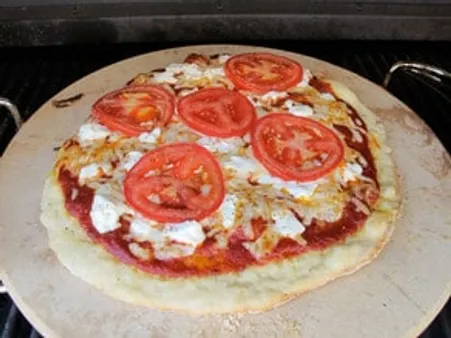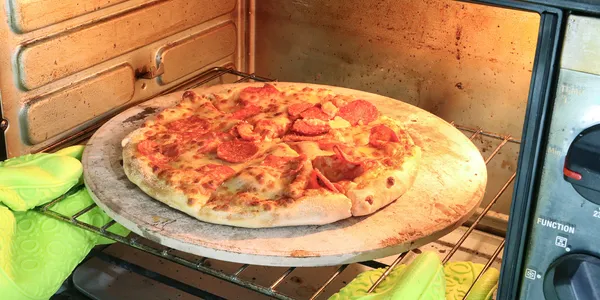Table of Contents
Tired of soggy, unevenly cooked pizza from your home oven? A pizza cooking stone might be your new best friend! At tauhuichiban, we're passionate about helping you elevate your culinary game. Pizza cooking stones are a simple yet game-changing tool for achieving that perfect crispy crust and evenly cooked toppings you crave. Let's dive into everything you need to know about pizza cooking stones!
Feature | Description |
|---|---|
Material | Ceramic, cordierite, steel - each with pros and cons |
Size & Shape | Choose based on your oven and pizza size preference |
Thickness | Thicker stones retain heat better but take longer to heat up |
Heating & Use | Always preheat thoroughly, use cornmeal or semolina for transferring pizza |
Cleaning | Hand wash only, avoid soap, allow to cool completely before cleaning |

Unlock The Magic Of Your Pizza Cooking Stone!
Choosing the Right Pizza Cooking Stone
What Material is Best for You?
Choosing a pizza cooking stone is like picking out a new pair of shoes - you want something that fits your needs and style. The first thing you need to decide is what material is best for you. Ceramic stones are known for being affordable and easy to use, but they can be a bit fragile. Steel stones are super durable and heat up quickly, but they can be more expensive. Cordierite stones are the rock stars of the pizza stone world - they're super heat-resistant, even and distribute heat beautifully, and they last forever! Think of it like this: ceramic stones are the friendly neighborhood bakery, steel stones are the fancy restaurant oven, and cordierite stones are the professional pizza chef's secret weapon.
Material | Pros | Cons |
|---|---|---|
Ceramic | Affordable, easy to use | Fragile, can crack easily |
Steel | Durable, heats up quickly | More expensive, can rust |
Cordierite | Durable, even heat distribution, long-lasting | Most expensive, takes longer to heat up |
How Big Should Your Pizza Stone Be?
Remember that time you tried to fit a giant pizza in your tiny oven and it ended up a crumpled mess? Yeah, we've all been there. You want to make sure your pizza stone is the right size for your oven and the pizzas you plan on making. If you're a solo pizza enthusiast, a smaller stone might be perfect. If you're feeding a crowd, you'll need a bigger stone to accommodate those giant, cheesy masterpieces. It's also important to consider the thickness of your stone. A thicker stone will retain heat better, but it will also take longer to heat up. A thinner stone will heat up quickly, but it might not be as good at retaining heat. Think of it like this: a thicker stone is like a warm hug on a cold day, while a thinner stone is like a quick burst of sunshine.
- Consider the size of your oven and the pizzas you plan on making.
- A thicker stone will retain heat better but takes longer to heat up.
- A thinner stone heats up quickly but might not be as good at retaining heat.
Don't Forget About the Shape!
Okay, now that we've talked about materials and size, let's talk about shape! You might think all pizza stones are round, but you'd be surprised. Some stones come in rectangular shapes, which can be really handy if you like to make rectangular pizzas. You can also find oval-shaped stones, which are perfect for those extra-long pizzas. Think of it like choosing the right plate for your meal - you want to make sure it fits the food perfectly!
Remember, there's no right or wrong answer when it comes to choosing a pizza stone. It's all about finding the one that fits your needs and your pizza-making style. So, go ahead, explore the world of pizza stones, and find your perfect match!

Choosing the Right Pizza Cooking Stone
Using Your Pizza Cooking Stone Like a Pro
Preheat, Preheat, Preheat!
You know how your mom always tells you to let the car warm up before driving in the winter? Well, it's kind of like that with your pizza cooking stone. You want to preheat it for at least 30 minutes before you slide your pizza onto it. This helps the stone get super hot and ready to cook your pizza evenly from edge to edge. Think of it like giving your stone a big warm hug before it starts its job! And remember, never put a cold stone into a hot oven - that's like jumping into an icy pool right after coming out of a sauna! It can cause the stone to crack or break.
Sliding Your Pizza On Like a Pro
Now comes the fun part - sliding your pizza onto the hot stone! To do this without making a mess, sprinkle some cornmeal or semolina on your peel (that flat wooden or metal thing you use to slide pizzas). The cornmeal acts like little ball bearings, helping your pizza slide smoothly onto the stone. If you don't have a peel, no worries! You can use a rimless cookie sheet or even an upside-down baking sheet as long as you've got those cornmeal "ball bearings" working for you. Just give it a little shimmy and shake when you're ready to slide it in - but be careful not to burn yourself on that hot oven!
- Preheat your pizza cooking stone for at least 30 minutes.
- Avoid putting a cold stone into a hot oven.
- "Ball bearing": Use cornmeal or semolina on your peel for easy sliding.

Using Your Pizza Cooking Stone Like a Pro
Cleaning and Caring for Your Pizza Cooking Stone
Now, let's talk about keeping your pizza stone happy. Think of it like taking care of your favorite pair of sneakers. You wouldn't just throw them in the washing machine, would you? Nope! You'd give them a good scrub and let them air dry, right? Same goes for your pizza stone! It's super easy to clean, and it'll thank you for it by making delicious pizzas for years to come.
First of all, don't even think about putting your pizza stone in the dishwasher! The harsh detergents and hot water can damage the stone and make it less effective. Instead, let it cool down completely after using it. Then, just give it a gentle scrub with a damp cloth or sponge. You can use a little bit of baking soda to help loosen any stubborn bits, but avoid using soap – it can leave a residue that affects your pizza's flavor. And remember, you don't want to use any abrasive cleaners or scrubbers, because they can scratch the surface of the stone.
- Let the stone cool down completely after using it.
- Use a damp cloth or sponge to clean it gently.
- You can use a little bit of baking soda to help loosen any stubborn bits.
- Avoid using soap or abrasive cleaners.
Once you've cleaned your pizza stone, let it air dry completely before storing it. You can store it on a shelf or in a cupboard, but make sure it's not stacked on top of other heavy items. And remember, don't be afraid to give your pizza stone a little TLC every now and then. A little bit of care goes a long way in keeping it in tip-top shape for years to come.
I learned this the hard way. One time, I was in a hurry and just threw my pizza stone in the dishwasher. Big mistake! It came out with a nasty crack right down the middle. Lesson learned! Treat your pizza stone with love and it'll reward you with delicious, crispy pizzas for years to come.
Do | Don't |
|---|---|
Cool down completely after using it | Put in the dishwasher |
Clean with a damp cloth or sponge | Use soap or abrasive cleaners |
Air dry completely | Stack on top of heavy items |

Cleaning and Caring for Your Pizza Cooking Stone
Final Thought
A pizza cooking stone is a worthwhile investment for any pizza lover who craves that perfect, pizzeria-quality crust from the comfort of their own home. By choosing the right stone, using it properly, and giving it the care it deserves, your pizza cooking stone will reward you with delicious, homemade pizzas for years to come. Happy cooking!